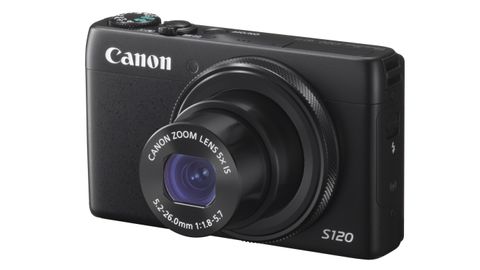TechRadar Verdict
The premium compact camera market is a crowded, but the S120 is one of the most solid performers you can buy. It's a good option for those who want top-notch image quality along with something that fits snugly in a pocket.
Pros
- +
Full manual control
- +
Raw format shooting
- +
Touchscreen
- +
Wi-Fi
Cons
- -
Limited Wi-Fi options
- -
Limited digital filter control
Why you can trust TechRadar
Canon generally releases its S range of premium compact cameras at the same time as it updates the G series, and it's no different this year with the introduction of the Canon PowerShot S120 to replace last year's Canon PowerShot S110.
As with its bigger sibling, much of the outward design of the S120 remains unchanged from its predecessor, but internally there have been some significant upgrades.
It is the first S series camera to feature a lens with an f/1.8 aperture. Its diminutive dimensions also make it the slimmest camera in the world to feature an f/1.8 optic. It's still a 5x optical zoom, starting at 24mm.

It also shares the same new 12.1 million pixel back-illuminated CMOS sensor as the Canon G16. Although pixel count remains the same as its predecessor, the new design should produce better images. Canon's latest processor, Digic 6, is also found in both models.
The special thing about Digic 6 in these models is that not only should low light performance be greatly improved from previous models, but continuous shooting can offer something pretty exciting. The S120 can shoot at 9.4fps (JPEG only, no continuous autofocus) without a buffer. That means that it can shoot, in theory, until your card is full without stopping. You can also stop shooting and restart without any lag.
Canon says that the autofocus speed of the S120 has been improved by around 50%. As before, both models feature full-manual control and raw format shooting. The S120 also features a control ring around the lens.
Unlike the G16, the S120's 3 inch screen is touch-sensitive. Both of the new models now feature Wi-Fi connectivity, with GPS available if used in conjunction with your smart phone.
A new introduction for both models is Star Mode, which has been designed to help those wanting to shoot night time photographs. Canon says that it is so confident of the camera's low light capability that it wants to actively encourage photographers to use the cameras in the dark.
Star Mode is a fully automatic mode which deploys the best settings for capturing the night sky. It also has the ability to capture star trails and time-lapse movies within the camera itself, without the need for post production work.

Background Defocus has also been added. This takes two images, one in focus and one out of focus, combining the results from the two automatically to produce a DSLR type shallow depth of field effect. HDR mode has been improved with new digital filters.
Manual focus peaking has been introduced on these new models for the first time in a Canon stills camera. We've seen this before on Canon video cameras and from other stills cameras manufacturers.
Full HD video recording is available at 60fps for smooth movies.
Whether the S120 is more appealing than the G16 will no doubt be down to personal taste on handling. As the two have very similar specifications, the S120 is worth considering if you're looking for something a little smaller but with fewer direct controls on the body. The S120 is also cheaper than the G16.
Amy has been writing about cameras, photography and associated tech since 2009. Amy was once part of the photography testing team for Future Publishing working across TechRadar, Digital Camera, PhotoPlus, N Photo and Photography Week. For her photography, she has won awards and has been exhibited. She often partakes in unusual projects - including one intense year where she used a different camera every single day. Amy is currently the Features Editor at Amateur Photographer magazine, and in her increasingly little spare time works across a number of high-profile publications including Wired, Stuff, Digital Camera World, Expert Reviews, and just a little off-tangent, PetsRadar.


